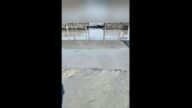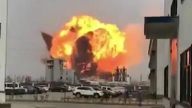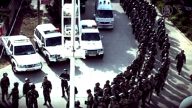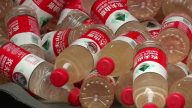【新唐人2013年06月15日訊】最近幾年,隨著中國城鎮化的擴大,一些原來的垃圾場,回收場以及化工企業用地,悄然變成了住宅區和商業區,然而這些被污染過的土地,其中的毒素釋放,會持續幾十年甚至上百年。因此居住在這些有毒土地上的民眾,受到的健康威脅令人怵目驚心。
英國《衛報》報導,中國兩位公民高勝科和王凱,近年來致力於調查和揭露中國城市受污染土地,一系列的報告,獲得了「中國對話」的最佳調查獎,和2013年《衛報》的中國環境報導獎。中國在受污染的土地上建築住宅樓問題,再一次引起媒體的關注。
報導說,有的農藥廠剛搬走,土壤還來不及修復,就被開發成樓房賣掉。
「台灣師範大學」化學系教授、環境毒理學專家吳家誠指出,污染過的土壤中存在著可揮發和不可揮發的兩種毒素,都會威脅到人體健康。
台灣師範大學化學系教授 吳家誠:「土壤或地下水有一些有機溶劑,像汽油這一類的東西污染的時候,它慢慢會揮發,有時會引發淋巴癌症,或血癌,以及呼吸器官的癌症都會產生。」
吳家誠指出,在很多殘留於土裡的工業材料中,存在不能揮發的重金屬,也會通過接觸方式對人體造成傷害,特別是小孩容易受影響。
吳家誠:「那另外一部分是不會揮發的,所謂建築業的建築廢液,電池回收工廠的一些材料等等之類,它裡面就有一些重金屬,它遍存我們居住環境的周圍,小孩出去玩耍的時候,可能身上或皮膚上就會粘到這些重金屬,還有可能帶入到體內,那這個時候對健康也會有影響。」
吳家誠說,對這種含有重金屬的區域,應該要有相關的法律配套措施。在台灣,通常會把土地整治乾淨後,才做後續利用。
上世紀70年代末,美國發現在原化學廢料填埋場上建起的住宅區,出現流產、死胎、腫瘤等現象後,制定了「棕地法案」。
吳家誠還指出,有些不易揮發的污染物,毒性釋放會長達幾十年,甚至上百年,易揮發的也要持續幾十年。
重慶從2004年到2012年,搬遷了137家污染工廠,這些廠區現在大多變成了主要的房地產區。江蘇則連續三年,搬遷了4,000多家污染嚴重的化工企業,留下多少大面積污染土地﹖還是未知數。
而在北京,2001年和2005年間,搬遷了142家工廠,空出了878萬平方米可重復用地。據中共北京環保局官員說,從2004年到現在,只有幾十個污染場址被確定。
另外,中國社會活動家胡佳反映,很多垃圾填埋廠,非金屬處理廠倒閉後,都開發成了住宅區或商業區。
中國社會活動家 胡佳:「因為土地是最有價值的,現在當局搞土地財政,聚斂財富,不管土地原來的用途是甚麼,你是核廢料的填埋場也罷,你是垃圾場也罷,你是冶煉的礦產這些東西也罷,它反正給你開發出來,只要能賣錢,出手以後就跟它無關了,這種東西在中國各地都是挺普遍的。」
胡佳表示,因為民眾不知情或缺乏這方面的知識,認為既然政府通過了,應該不會有問題。胡佳說,這些樓房一出來,同樣出手很快。
在中國,農藥廠通常把農藥殘留和有害化學殘留物,現場掩埋到地面以下五、六米深處。2004年4月,北京南三環地鐵施工現場,三名工人在地下作業時中毒。那裏原來是一個農藥廠。
2006年7月,蘇州南二環路附近,一家化工廠搬走後,留下20畝受污染的土地,現場的6名建築工人在挖土時昏迷。
2007年中國新年期間,在武漢鶴山一個施工現場,當開挖到深層的土壤時,工人們一個接一個出現頭暈,呼吸困難。最後,數名中毒工人被送往醫院接受緊急治療,那裏是一個農藥廠的舊址。
採訪編輯/劉惠 後製/李若琳
Building Development on Toxic Land in China
With expansion of urbanization in China in recent
years, land originally used as garbage dumps,
recycling yards and chemical enterprises has quietly
been turned into residential and commercial areas.
This land is contaminated, where toxins continue
to be released for decades or even centuries.
For people living on this toxic lands,
the threat to their health is shocking.
According to The Guardian, two Chinese citizens,
Wang Kai and Gao Shengke had been working to
investigate and expose contaminated urban land.
They have generated a series of reports.
They won China Dialogue best investigation award, and
Guardian’s 2013 China Environmental Reporting Award.
Residential buildings on contaminated land
has once again attracted media attention.
It was reported that after some pesticide factories
relocated, and before the soil was decontaminated,
it was developed into a residential building for sale.
Wu Jiacheng, professor of chemistry are Taiwan Normal
University, and environmental toxicology expert, commented.
Contaminated soil has volatile and non-volatile
toxins, and all are a threat to human health.
Professor Wu Jiacheng: “Soil or groundwater has some
organic solvents, such as gasoline contamination or similar.
This will slowly evaporate, and sometimes cause lymphatic
cancer, or leukemia, and cancer of the respiratory organs.”
Wu Jiacheng said that non-volatile heavy metals
remain in the soil within many industrial materials.
They will cause harm to humans
on contact, especially children.
Wu Jiacheng: “The non-volatile parts, such as the so-called
construction waste, or some battery recycling plant materials,
have heavy metals inside, spreading into the environment.
When children play outside, these heavy
metals may stick to their skin or body.
They may even enter inside their bodies,
which can also affect their health.”
Wu Jiacheng said that for areas containing heavy metals,
it should have a system of laws and supporting measures.
In Taiwan, they will usually conduct land
remediation before subsequent usage.
In the late 1970s, incidents occurred in the United States.
In residential areas where land was originally
used as chemical waste landfill, miscarriages,
stillbirths, cancer and other phenomena appeared.
This led to the creation of the Brownfield Bill.
Wu Jiacheng also notes that with some
non-volatile contaminants, toxic release
will last for decades, or even centuries.
Even volatile ones will last for decades.
From 2004 to 2012, 137 polluting
factories had relocated in Chongqing.
Most of these plant areas have now
become major real estate areas.
In three consecutive years, more than 4,000 polluting
chemical companies relocated in Jiangsu Province.
How many large areas of contaminated
land still remain? It is still unknown.
In Beijing, from 2001 and 2005, 142 factories relocated,
leaving 8.78 million square meters of land for a new use.
According to the Beijing Environmental Protection
Bureau, from 2004 to the present, only a few
dozen contaminated sites were identified.
Chinese social activist Hu Jia commented.
After closure of many landfills and non-metallic
treatment plants, the areas were all developed
into residential or commercial areas.
Hu Jia: “Because land is the most valuable,
authorities engage in land finance to collect wealth.
This is regardless of the original land usage.
No matter whether it was nuclear waste
landfill, a garbage dump or mineral plant,
they will be developed into real estate
areas, as long as it could make money.
Once sold, it has nothing to do with them any
more. This is quite common everywhere in China.
Hu Jia said that because people did not know it,
or lacked related knowledge, they thought that
if the government allowed it, it wasn’t a problem.
Hu said that once these buildings went
on the market, they were sold quickly.
In China, pesticide plants usually bury pesticide residues
and harmful chemical residues in 5-6 meter deep pits.
In April 2004, at a Beijing subway construction
site of the South Third Ring Road, three workers
were poisoned when working underground.
It was because a pesticide plant was originally there.
In July 2006, near the South Second Ring
Road in Suzhou, a chemical plant relocated.
It left 20 acres of contaminated land, and six
construction workers went into a coma when digging.
During 2007 Chinese New Year period, at a
construction site in Heshan, Wuhan, suffered dizziness,
and began to have difficulty breathing one by one.
This was when they were doing deep soil excavations.
Finally, a number of poisoned workers were
taken to hospital for emergent treatment.
It was also previously a pesticide plant.



























